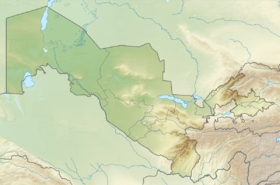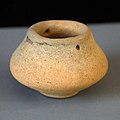Fayaz Tepe
37°17′11″N 67°11′17″E / 37.286265°N 67.188027°E Fayaz Tepe, also Fayoz-Tepe, is a Buddhist archaeological site in the Central Asia region of Bactria, in the Termez oasis near the city of Termez in southern Uzbekistan.[1][2] Located 15 km west of Termez off the main M39 highway. Bus number 15 runs past the turn-off to Fayaz Tepe, from where it is a 1 km walk without shade. The foundations of the site date to the 1st century CE, with a peak of activity around the 3rd and 4th centuries during the
History
The Fayaztepa complex is located in
After the square of Fayaztepa was cleared of sand dunes, the architecture of the monument began to be studied. Fayaztepa consists of three monumental structures: a temple in the central part, a monastery in the northwest, and utility buildings in the southeast. The total area of the complex is 1.5 square kilometers.
Originally, many of the monuments were red in color but were later covered in gold paint.
The temple courtyard is in the shape of a rectangular
Location
It is located in the northwest of the ruins of the Old Termiz city near the city of Termiz, 1 km northeast of the complex of Buddhist structures of Karatepa, in the neighborhood of Al-Hakim al-Tirmidhi, Termiz district.[8]
Destruction
Fayoztepa became a ruin as a result of the invasion attacks of the Iranian Sassanids. In the 1st half of the 5th - 6th centuries, the ruins of the temple were used by the
Site
The site of Fayaz Tepe is located a few hundred meters from Kara Tepe, not far from the city of Termez.
-
Model of the Stupa and monastery
-
Site of Fayaz Tepe
-
Fayaz Tepe columns
-
Fayaz Tepe, Monastery, Court
-
Fayaz Tepe, Stupa
-
Fayaz Tepe, Stupa, inside
Artefacts
From the site were recovered numerous Buddhist frescoes and reliefs, now mostly located in the State Museum of History of Uzbekistan in Tashkent.[1] A famous niche showing the Buddha and two monks is dated to the 3rd-4th century CE.[14][15] An inscription has been found recently, which mentions the Kushan king Huvishka.[1]
-
A group of courtiers.[16]
-
Seated Buddha
-
Fayaz Tepe, Miniature vessel
-
Fayaz Tepe, Pottery with an Indian inscription
-
Fayaz Tepe, Sun god
-
Fayaz Tepe mural (men in caftan and boots)
-
Fayaz Tepe mural of deity with horns
See also
References
- ^ ISBN 978-1-78042-894-9.
- ^ Muzio, Ciro Lo. The Legacy of Gandhāra in Central Asian Painting". p. 116.
- ISBN 978-93-85714-95-5.
- ISBN 978-81-208-1540-7.
- ^ a b c d "O'ZBEKISTON TARIXIY-MADANIY YODGORLIKLARI: FAYOZTEPA BUDDAVIYLIK IBODATXONA MAJMUASI". uzbekistan-geneva.ch. Retrieved 2023-11-07.
- ^ a b Альбаум (1974). Раскопки буддийского комплекса Фаяэтепа [Excavations of the Buddhist complex of Phayaetepa] (in Russian).
- ^ a b c d e f g "Fayoztepa – asrlar qa'riga sayohat". uza.uz- National Information Agency of Uzbekistan. Retrieved 2023-11-07.
- ^ a b c d e f g h i j k "Fayoztepa yodgorligi". termez-travel.uz. Retrieved 2023-11-07.
- ^ "Fayoztepa yodgorligi qanday haqiqatdan dalolat beradi?". m.kun.uz. Retrieved 2023-11-07.
- ^ "Noyob topilmalar: Fayoztepa". visittashkent.uz. Retrieved 2023-11-07.
- ^ "Fayoztepa haqida nimalarni bilamiz ?". uzbekistan.travel. Retrieved 2023-11-07.
- ^ Козловский (1974). изучению древних памятников материальной культуры Сурхандарьинской области [studying ancient monuments of material culture of Surkhandarya region] (in Russian).
- ^ Uzbekistan, National Encyclopedia. Tashkent, 2005. Volume 9. Str. 167.
- ^ ISBN 978-90-04-12848-4.
- ^ ISBN 978-90-04-12848-4.
- ^ a b Lo Muzio, Ciro (2012). "Remarks on the Paintings from the Buddhist Monastery of Fayaz Tepe (Southern Uzbekistan)". Bulletin of the Asia Institute. 22: 189–206.
- ^ Muzio, Ciro Lo. The Legacy of Gandhāra in Central Asian Painting". p. 130, Plate 3.13.











![Niche with the Buddha and two monks, 3rd-4th century CE.[14][15]](http://upload.wikimedia.org/wikipedia/commons/thumb/8/83/Fayaz_Tepe%2C_Seated_Buddha.jpg/106px-Fayaz_Tepe%2C_Seated_Buddha.jpg)


![A group of courtiers.[16]](http://upload.wikimedia.org/wikipedia/commons/thumb/9/91/Fayaz_Tepe%2C_Wall_Painting_of_a_group_of_courtiers.jpg/110px-Fayaz_Tepe%2C_Wall_Painting_of_a_group_of_courtiers.jpg)

![A devotee with horns, possibly a Kushano-Sasanian motif.[17][16]](http://upload.wikimedia.org/wikipedia/commons/thumb/6/65/Fayaz_Tepe%2C_wall_painting_of_Alexander_the_Great.jpg/120px-Fayaz_Tepe%2C_wall_painting_of_Alexander_the_Great.jpg)





